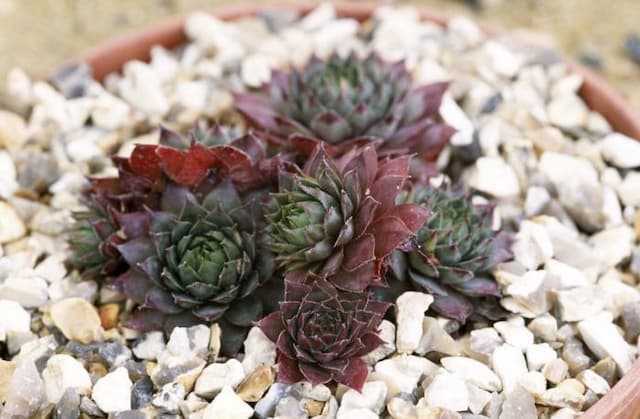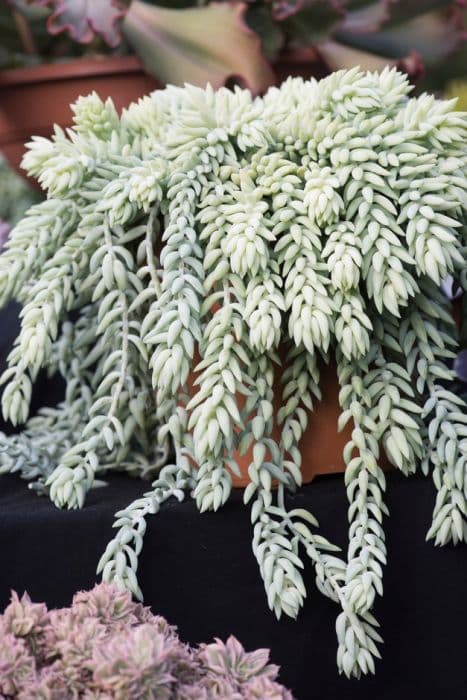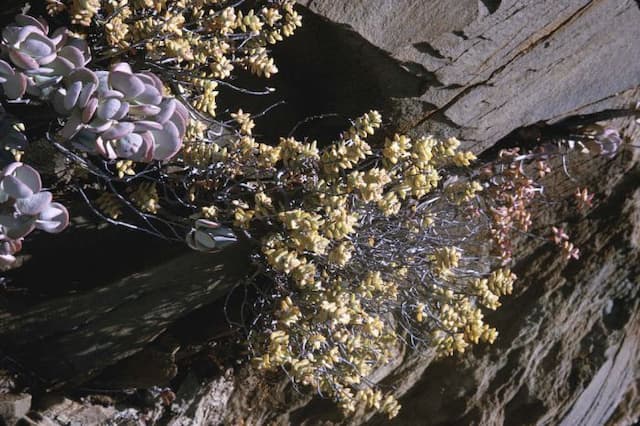Tree Aeonium Aeonium arboreum subsp. holochrysum

ABOUT
The plant commonly known as the tree aeonium has a distinctive appearance marked by its succulent features. It is characterized by rosettes of leaves that are fleshy and spoon-shaped, coming together to form a geometric pattern. These leaves are glossy and often have a striking coloration, ranging from deep green to purplish tones, sometimes appearing almost black depending on the variety and environmental conditions. The leaves typically have a waxy coating which helps the plant retain moisture, making it well-suited to dry climates. As the plant matures, the lower leaves may drop off, revealing a branching stem that lends the plant a tree-like structure. During its blooming period, the tree aeonium produces conical clusters of small, star-shaped flowers. These flowers are usually a shade of yellow, which adds a vibrant contrast to the dark foliage. The blooms are often plentiful and can add significant visual interest to the plant. The overall growth pattern and symmetry of the tree aeonium's rosettes make it a popular choice for ornamental use in gardens and as a potted plant in home settings. It is a low-maintenance plant, requiring minimal water and thriving in well-drained soils. The tree aeonium's striking silhouette and elegant leaf rosettes make it a standout among succulent enthusiasts.
About this plant
 Names
NamesFamily
Crassulaceae.
Synonyms
Tree Aeonium, Tree Houseleek, Irish Rose, Houseleek Tree.
Common names
Sempervivum arboreum, Aeonium manriqueorum.
 Toxicity
ToxicityTo humans
The Aeonium arboreum, commonly known as Tree Aeonium, does not have notable toxicity to humans. Generally, it's considered non-toxic, and there are no significant symptoms associated with ingesting it. However, as with many plants, it's possible for sensitive individuals to experience mild irritation or an allergic reaction if they have a sensitivity to the plant.
To pets
The Aeonium arboreum, or Tree Aeonium, is also not known to be toxic to pets. It is generally safe around cats and dogs, with no significant toxic effects reported from ingestion. However, pet owners should always monitor their pets and prevent them from eating large quantities of any non-food plants, as they can potentially cause gastrointestinal upset or an allergic reaction in sensitive animals.
 Characteristics
CharacteristicsLife cycle
Perennials
Foliage type
Evergreen
Color of leaves
Green
Flower color
Yellow
Height
2 feet (0.61 meters)
Spread
3 feet (0.91 meters)
Plant type
Succulent
Hardiness zones
9
Native area
Canary Islands
Benefits
 General Benefits
General Benefits- Ornamental Appeal: Aeonium arboreum, commonly known as Tree Aeonium, adds aesthetic value to gardens and homes with its rosettes of fleshy leaves and attractive growth habit.
- Drought Tolerance: Being a succulent, Tree Aeonium is highly drought-tolerant, requiring minimal watering and capable of surviving in dry climates.
- Easy Propagation: Tree Aeonium can be easily propagated from cuttings, making it simple for gardeners to multiply their plants and share with others.
- Low Maintenance: This plant requires very little care once established, making it an ideal choice for gardeners of all levels.
- Attracts Pollinators: The flowers of Tree Aeonium, when in bloom, can attract bees and other pollinators to the garden.
- Suitable for Containers: Due to its moderate size, Tree Aeonium is well-suited for container gardening, allowing for flexibility in placement and design.
- Year-Round Interest: With evergreen leaves, Tree Aeonium provides visual interest in the garden throughout the entire year.
 Medical Properties
Medical PropertiesThis plant is not used for medical purposes.
 Air-purifying Qualities
Air-purifying QualitiesThis plant is not specifically known for air purifying qualities.
 Other Uses
Other Uses- Aeonium arboreum subsp. holochrysum, commonly known as 'Bejeque,' can be used as a natural dye source for fabrics, giving a yellow or green hue depending on the mordant used.
- Bejeque leaves can be crushed and mixed into paint mediums to create a natural, plant-based pigment for art projects.
- The sticky sap from Bejeque can be used as a rudimentary adhesive in simple crafts or as a temporary hold for light materials.
- The thick leaves of Bejeque can be used in floral arrangements to provide a striking and architectural green element.
- Bejeque can serve as living mulch in garden beds, helping to retain soil moisture and prevent weed growth due to its dense foliage.
- The succulent's unique texture and form can be used in photography as a subject to explore patterns and micro-landscapes in macro photography.
- Bejeque can be used in educational settings to teach about water conservation and adaptations of plants in arid environments.
- As a model organism, Bejeque can be used in botanical studies to better understand succulent growth patterns and responses to environmental stressors.
- The rosettes of Bejeque can be used as a natural barometer; their leaves tend to close tighter in response to humidity changes, indicating weather shifts.
- Bejeque can be integrated into green roofing designs to provide insulation due to its heat and drought tolerance.
Interesting Facts
 Feng Shui
Feng ShuiThe Aeonium arboreum, commonly known as "Tree Houseleek," is not commonly referenced in traditional Feng Shui practice.
 Zodiac Sign Compitability
Zodiac Sign CompitabilityThe Tree Houseleek is not used in astrology practice.
 Plant Symbolism
Plant Symbolism- Resilience: Aeonium arboreum subsp. holochrysum, or "Tree houseleek," is known for its ability to thrive in rocky, arid environments, symbolizing the capacity to endure and persist through tough conditions.
- Adaptability: The ability of the Tree houseleek to adapt to varying light conditions and sparse water supplies signifies its symbolism for adaptability and flexibility in life.
- Timelessness: The succulent nature of the Tree houseleek, with its perennial growth and year-round foliage, represents timelessness and longevity.
- Prosperity and Wealth: In some cultures, succulents like the Tree houseleek are believed to bring prosperity and wealth, due to their plump, fleshy leaves that can store water.
- Protection: The thick, waxy leaves of the Tree houseleek are evolved to retain water and protect the plant from harsh sunlight, symbolizing protection and self-defense.
 Water
WaterThe Aeonium 'Sunburst' prefers to be watered deeply but infrequently. It's essential to let the soil completely dry out between waterings to prevent root rot. Typically, water approximately once every 7 to 10 days during the active growing season in spring and summer, using roughly 8-16 ounces of water per plant each time, depending on the pot size and soil conditions. During the dormant winter period, reduce watering to once a month or less. Always adjust watering frequency based on humidity, temperature, and light conditions.
 Light
LightAeonium 'Sunburst' thrives in bright, indirect sunlight. The best spot for this succulent is a location where it can receive partial sun to light shade, avoiding the intense midday sun which can scorch its leaves. An east or west-facing window is often ideal for providing the necessary light conditions inside a home.
 Temperature
TemperatureAeonium 'Sunburst' prefers moderate temperatures, ideally between 65°F and 75°F. However, it can tolerate temperatures as low as 40°F and as high as 100°F for short periods. To encourage optimal growth, avoid exposure to temperatures below 40°F, as it can damage the plant.
 Pruning
PruningPrune the Aeonium 'Sunburst' to maintain its shape, remove damaged or spent leaves, and encourage bushier growth. Prune in spring or early summer, at the start of the growing season. Snip off any leggy stems and unwanted growth using clean, sharp scissors or pruning shears. Pruning every year or every other year is generally sufficient.
 Cleaning
CleaningAs needed
 Soil
SoilThe best soil mix for Aeonium arboreum, commonly known as Tree Aeonium, is a well-draining cactus or succulent mix with added perlite or pumice to increase aeration. It prefers a soil pH between 6.0 and 7.5.
 Repotting
RepottingTree Aeoniums should be repotted every two to three years or when they outgrow their current container, using fresh succulent mix to refresh nutrients.
 Humidity & Misting
Humidity & MistingTree Aeonium prefers a lower humidity level, typical of its native Canary Islands habitat, and tolerates dry air conditions well.
 Suitable locations
Suitable locationsIndoor
Place in bright, indirect light, and allow soil to dry out.
Outdoor
Plant in full sun to partial shade with great drainage.
Hardiness zone
9-11 USDA.
 Life cycle
Life cycleAeonium arboreum subsp. holochrysum, commonly known as the Gold Dust Aeonium, begins its lifecycle as a seed, which upon germination produces a tiny rosette. As the plant matures, the rosette grows and can reach up to several inches in diameter, with fleshy leaves that have a waxy coating and may show hints of gold or yellow. The Gold Dust Aeonium is a monocarpic perennial, so it flowers once in its lifetime, usually after several years, sending up a tall flower spike with numerous small, star-shaped blooms, typically yellow or white. After flowering, the main rosette dies, but the plant often produces offsets, or pups, from the base, which continue to grow and can be used for propagation. These offsets can rapidly develop into independent plants when the conditions are right, allowing the Aeonium to spread and continue its life cycle. The plant goes through a dormant phase during hot summer months, minimizing growth to conserve energy and water, before resuming activity in cooler months.
 Propogation
PropogationPropogation time
Spring to Summer
Propogation: The Aeonium arboreum subsp. holochrysum, commonly referred to as the Canary Island Aeonium, is commonly propagated through stem cuttings. The ideal time to propagate is during the plant's active growth period, which typically falls in spring or early summer. To propagate by stem cuttings, a healthy, non-flowering stem is selected and cut with a clean, sharp instrument, making sure the cutting is about 2 to 4 inches (5 to 10 cm) long. The cut end is allowed to callus over for a few days to prevent rot when planted. Once callused, the cutting is placed in well-draining soil and watered lightly until roots develop, after which the watering regimen can increase gradually as the plant establishes. This method is favored for its ease and the high success rate in producing new, healthy plants.









